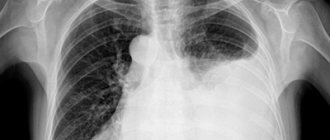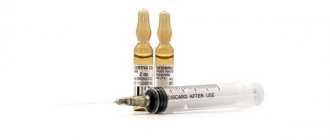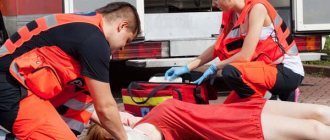Internal bleeding of the stomach is not an independent disease, but acts as a symptom and complication of other diseases. It is important to understand that this symptom occurs not only when the stomach is damaged, but can also indicate problems not related to the gastrointestinal tract: blood clotting disorders, vascular diseases, metastatic growth of a tumor from a neighboring organ.
General symptoms, the severity of the patient’s condition, and diagnostic studies allow the doctor to correctly determine treatment tactics.
Causes of stomach bleeding
Often the cause of stomach bleeding is an untreated ulcer.
The main causes of hemorrhages can be divided into frequent, infrequent and rare.
Frequent sources of the problem:
- An ulcer is a serious disease that is often life-threatening. Bleeding can occur either from a new “young” ulcer or from a chronic one. Long-existing ulcers are dangerous due to more massive bleeding, especially when it is located on the lesser curvature of the stomach. This is due to anatomical features - large branches of the left gastric artery are located here.
- Tumors cause acute bleeding only in 10% of cases; more often, bleeding is detected in the same way as with erosion - during FGS or stool examination.
- Erosion is superficial destruction of the gastric mucosa. In most cases, they are multiple, located in the fundus of the stomach, less often in the antrum. Heavy (profuse) bleeding with erosive gastritis is rare; more often it is drip leakage of blood, which is detected by chance, during FGS or stool examination for occult blood.
- Mallory-Weiss syndrome - occurs when the cardiac part of the stomach is ruptured in the longitudinal direction. This situation is possible when there is a sudden increase in pressure in a full stomach. It occurs in pregnant women with severe toxicosis (due to constant vomiting), athletes when lifting weights, and blunt abdominal trauma.
The following processes are less common:
- Henoch-Schönlein disease (hemorrhagic vasculitis) - after some kind of infection (ARVI, laryngitis, tonsillitis), toxic damage to the capillaries occurs and multiple hemorrhages occur throughout the gastrointestinal tract.
- Postoperative gastric ulcer.
- Acute leukemia.
- Gastroesophageal reflux disease.
- Iatrogenic damage (taking non-steroidal anti-inflammatory drugs, corticosteroids, antihypertensive drugs)
The rarest causes are: scurvy, hemophilia, thrombocytopenic purpura, aplastic anemia, sarcoidosis.
The main diseases that lead to stomach bleeding are listed here, but in general there are many more of them.
Features of internal hemorrhages
For those wishing to provide first aid in road traffic accidents, it is enough to study the basic concept and types of external bleeding about blood loss, since possible hidden hemorrhages are diagnosed by specialists in medical institutions. The satisfactory state of health of victims after injury should not be a reason for avoiding further examination:
- external injury to the abdominal cavity is associated with hemorrhage from the liver, intestines, and other gastrointestinal organs;
- injuries to the lumbar region sometimes lead to kidney rupture.
Treatment of mixed bleeding in injuries is carried out in most cases by surgical methods, by opening the corresponding cavity, ligating blood vessels, and removing part of the damaged organ. Conservative measures with constant medical supervision are carried out only if there is insignificant blood loss.
The most common non-traumatic types of internal bleeding are:
- from the upper and middle sections of the digestive system - esophagus, stomach, liver;
- their lower sections - the large and small intestines.
Pathological conditions can be caused by peptic ulcers, gastritis, tumors, thrombosis of mesenteric vessels and other diseases. As part of the diagnosis, special studies are carried out. Depending on the causes of hemorrhage, the choice of conservative or surgical methods depends. Treatment includes replenishment of circulating blood, elimination of the causes of blood loss, and complex therapy of the underlying disease.
Hidden bleeding is determined by indirect manifestations. Accumulations of blood fluid in the cavities put pressure on the internal organs, interfere with their functioning, and cause complications. Many signs of internal bleeding are general:
- weakness;
- drowsiness;
- pale skin;
- low blood pressure;
- frequent heartbeat.
Specific symptoms in clinical practice appear with a more thorough examination and establishment of cause-and-effect relationships.
Signs of bleeding. Table 2.
| Problem | Symptoms |
| Hemothorax | Shortness of breath, difficulty breathing, weakening of percussion sound in the lower chest |
| Hemopericardium | Feeling of fear, sweating, pain in the heart, swelling of the veins of the neck, face, limbs |
| Bleeding into the abdominal cavity | Abdominal bloating, pain in the upper parts on palpation |
| Bleeding in the skull area | Dizziness, fainting, other neurological disorders |
The leakage of blood from the vascular bed negatively affects the entire body. Due to a decrease in total circulating blood, cellular nutrition and cardiac activity deteriorate, and anemia develops. The consequence is complications in the form of foci of necrosis in the liver, acute pulmonary failure, manifestations of anuria, parenchymal jaundice, and other pathologies.
- Signs of arterial bleeding and first aid
Obvious internal bleeding, with traces of blood leaking into the external environment, manifests itself as follows:
- gastrointestinal bleeding - modified blood gradually comes out in the process of vomiting dark blood, tarry black stools (melena) are formed;
- bleeding in the lung - expectoration of light, bright scarlet blood;
- hemorrhage from the renal pelvis, bladder - hematuria and blood in the urine are observed.
Some chronic pathologies are associated with the risk of internal bleeding. The presence of the first symptoms is a signal for an urgent visit to the attending physician.
Symptoms of acute gastric bleeding
Internal bleeding of the stomach can be hidden or obvious
Symptoms of acute bleeding depend on a group of factors: the rate of blood loss, the volume of fluid lost, the person’s age, and the presence of additional diseases.
In the clinic of acute bleeding, two periods are distinguished: latent and obvious.
The first occurs from the moment blood enters the intestines from the stomach. The second is from the moment blood is detected in vomit, feces or gastric contents (with FGS).
The severity of the clinical manifestations directly depends on the rate of blood loss. If it is more than 750 ml per day, the patient feels weakness, sweating, and severe headache. As blood pressure drops, a person notices a noise in the head, “flickering of spots,” and fainting occurs. In some cases, the only sign of bleeding is sudden loss of consciousness.
Vomiting indicates the presence of bleeding; its color can indicate the massiveness of blood loss. “Coffee grounds” indicates slight bleeding, since hemoglobin has time to turn into hydrochloric acid hematin under the influence of hydrochloric acid.
With heavy bleeding, cherry-colored vomit. If the blood is bright red, the bleeding most likely comes from the esophagus or is very massive in the stomach. Vomiting is often one-time, its repetition within two hours indicates continuous bleeding.
Drug therapy
Treatment of diseases that cause bleeding from the uterus is carried out in a hospital setting. Additionally, the doctor prescribes medications to the patient to help stop bleeding. Hemostatic medications are taken only on the recommendation of a medical specialist; taking medications at your own discretion is strictly prohibited. Below is a list of medications most commonly used to stop bleeding.
- Etamsylate - This drug stimulates the synthesis of thromboplastin and changes the permeability of blood vessels. Blood clotting increases, resulting in decreased bleeding. The medication is intended for intramuscular injection.
- Oxytocin is a hormonal drug often used during labor to improve uterine contractility. As a result of contraction of the uterine muscles, bleeding stops. The drug oxytocin is prescribed for intravenous administration with the addition of glucose and has a large list of contraindications.
- Aminocaproic acid - This medicinal substance prevents blood clots from dissolving under the influence of certain factors, thereby reducing bleeding. The medicine is either taken orally or administered intravenously. Treatment of uterine bleeding with aminocaproic acid is carried out under close medical supervision.
- Vikasol - The drug is based on vitamin K. With a deficiency of this vitamin in the body, blood clotting worsens. The medication is prescribed to patients who have a tendency to uterine bleeding. However, vitamin K begins to act only 10–12 hours after entering the body, so it is not advisable to use the drug to stop bleeding in emergency cases.
- Calcium gluconate - The drug is prescribed for calcium deficiency in the body. Deficiency increases the permeability of vascular walls and impairs blood clotting. This medicine is also not suitable for use in emergency cases, but is used to strengthen blood vessels in patients prone to bleeding.
Symptoms of chronic bleeding
Internal stomach bleeding leads to severe anemia
Symptoms of chronic blood loss are vague and depend on the degree of iron deficiency anemia. Often the body compensates for losses so well that the patient walks independently and lives a normal life with a hemoglobin level of 30-40 g/l. The main symptoms of chronic gastric bleeding are signs of anemic syndrome. Severe weakness and fatigue appear, which increases even from slight physical activity.
The condition of the skin changes: the skin is pale, dry, flaky, and “stubs” appear in the corners of the mouth. Women immediately notice brittle nails and cracks in the skin of their hands.
With severe anemia, patients feel tachycardia even at rest, and shortness of breath appears. The condition of the oral cavity changes - there is a burning sensation in the tongue, difficulty swallowing, redness of the tip of the tongue. Sometimes there is hoarseness, coughing, redness and itching in the palate.
In especially severe cases, olfactory tastes change - patients may fall in love with the musty air of the basement, the smell of shoe polish or car tires. Sometimes there is a desire to eat sand or earth.
Treatment
In the acute period, the following manipulations are performed to stop bleeding:
- Drug hemostasis: the patient is injected intramuscularly with hemostatic drugs (Vikasol, Etamzilat, Aminocaproic acid).
- Endoscopic hemostasis (vessel clipping, photocoagulation, sclerotherapy).
- Arterial embolization.
- Surgical intervention (vascular ligation).
At the same time, the volume of circulating blood is replenished: saline solutions are administered (Disol, Trisol, Ringer's solution), microcirculation in the vessels is improved (Reopoliglyukin).
In case of severe blood loss, blood is transfused and iron-containing drugs are administered. In the future, iron supplements are prescribed for 3-6 months.
After stopping the bleeding, treatment tactics will depend on the disease that caused the disease.
First aid
For stomach bleeding, there is little that can be done at home. If you suspect a pathology, you must:
- urgently call an ambulance;
- the patient should be placed with the leg end raised; if he loses consciousness, the head must be turned to the side to prevent aspiration of vomit;
- Ice should be placed on the patient’s stomach;
- You cannot give food or drink, or take medications on your own.
General rules of first aid for bleeding
If the victim has lost a significant amount of blood, try to lay him down and elevate his legs.
Do not touch the wound with your hands or remove glass shards from it.
If sand and rust get into the wound, do not wash the damage, as this will increase the bleeding.
If the wound becomes dirty, you need to carefully remove the dirt in the direction from the wound, then treat the cleaned edges with an antiseptic.
When treating the edges of a wound with an iodine solution, do not allow the antiseptic to get inside the wound.
Depending on the type of blood loss, try to stop the bleeding using a tourniquet, twisting, or squeezing the damaged vessel.
First aid for capillary bleeding
Bleeding from the capillaries is not accompanied by large blood loss and stops relatively quickly. A sign of capillary damage is the appearance of a gentle stream of blood on the wound.
First aid for this bleeding includes treating the edges of the wound with an alcohol antiseptic (iodine), on which an aseptic gauze bandage is applied. Please note that the bandage is not tight. Usually, with capillary bleeding, there is no need to go to the hospital, with the exception of situations where the damage is extensive.
1 First aid for bleeding
2 First aid for bleeding
3 First aid for bleeding
First aid for venous bleeding
A sign of venous bleeding is rapidly flowing dark blood. Its flow is uniform, without gushing or pulsating.
With venous bleeding, blood clots may appear; they cannot be removed, since in this case blood loss may increase.
To stop bleeding, apply a pressure aseptic bandage to the wound. If blood loss continues, it is necessary to apply a tourniquet below the damaged area. To reduce injury to soft tissues and skin, a soft pad is placed on them (under the tourniquet). It is necessary to make a note indicating the time of application of the tourniquet. The maximum time for wearing a tourniquet is 2 hours in warm weather and 1 hour at sub-zero temperatures. The tourniquet cannot be held longer than this time, otherwise the bloodless tissue will begin to die. If you don’t have a tourniquet, you can make twists from available materials: a bandage, a belt, a towel, a piece of fabric using a handle and a short stick. The time frame for the spins is the same. Try not to use any hemostatic drugs without a doctor's prescription.
First aid for arterial bleeding
Arterial bleeding is one of the most dangerous. The main sign of arterial damage is bright scarlet blood flowing out in a pulsating stream at high speed. If large arteries are damaged, the blood begins to flow intermittently, like a fountain.
First aid for this bleeding is to apply a hemostatic tourniquet above the level of the wound. You can also use a twist. Time restrictions are the same.
If there is no tourniquet or twist, you can stop the bleeding by pressing the artery above the damaged area with your finger, i.e. at the pulsation point.
In case of bleeding from the brachial, ulnar, femoral or popliteal artery, you can fix the arm or leg as bent as possible in an elevated position.








